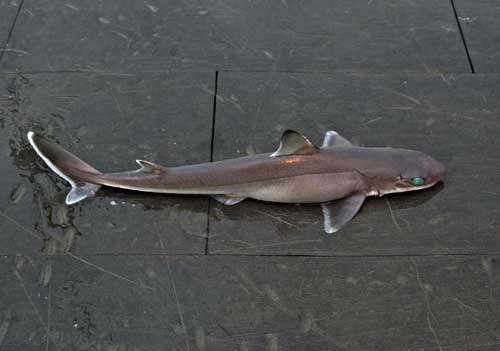
|
|
|
|
|
|
Shark Info (12-20-2002) |
Author |
|
Intro: |
Shark Info |
|
Main article: |
Dr. A. J. Godknecht |
|
Article 1: |
CITES Appendix II to finally include whale sharks and basking sharks |
Shark Info |
Article 2: |
Dr. A. J. Godknecht, Dr. G. D. Guex |
|
Fact Sheet: |
Shark Info |
|
Fact Sheet: Cuban dogfish
Biology of the Cuban dogfish (Squalus cubensis)This small dogfish species is indigenous to deep waters, preferring warm to tropical waters. They live primarily on the outer Continental Shelf where they swim in depths varying between 60 to 380 meters. DescriptionCuban dogfish have long spines on both dorsal fins, the first spine being approximately as long as the base of the first dorsal fin. The first dorsal fin spine begins just behind the base of the pectoral fins. The pectoral fins have a strongly concaved back edge. All fins peter out at the free end close to the body. As with all dogfish the Cuban dogfish has no anal fins. ColoringThe back is gray-brown, the belly is white. The tips of both dorsal fins are dark and the fins have a light-colored to white border. DistributionCuban dogfish are found in the Western Atlantic from North Carolina to Florida. They also inhabit the waters near Cuba, Hispaniola (Dominican Republic and Haiti) and the northern Gulf of Mexico from Mexico to Florida. In South America they are found in southern Brazil and Argentina. SizeThe shark’s maximum size is presumed to be around 110 cm, the average size about 75 cm. They reach sexual maturity at a length of approximately 50 cm. FeedingCuban dogfish probably feed on fish and invertebrates living on the ocean floor such as crustaceans/crabs and mussels. ReproductionCuban dogfish reproduce ovoviviparously and have about 10 pups per litter. As opposed to adults, the young are usually found in less deeper waters of the Continental shelf. Similar SpeciesDue to their limited range of distribution and typical appearance, there is no danger of mistaking them for other dogfish species. Encounters with HumansAlthough the spines on the dorsal fins can cause painful stings, this shark species is harmless to man because of its size and preference for deep waters. Degree of EndangermentCuban dogfish are mainly fished commercially in the northern Gulf of Mexico by trawl-net fishermen. They are caught primarily for their large liver which is rich in oils and vitamins and is seldomly eaten. Information on population numbers are only sparsely available, but overfishing certainly poses a threat because they are commercially fished.
Source: L. J. V. Compagno, 1984, FAO Species Catalogue, Vol. 4, Part 2. May be published only by indicating the source: Shark Info |
|
|
|
|
|
|||||
